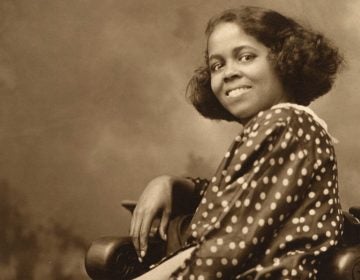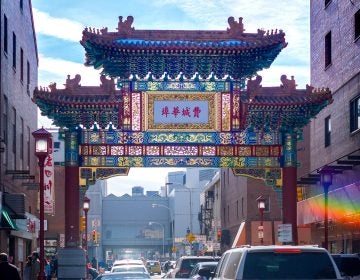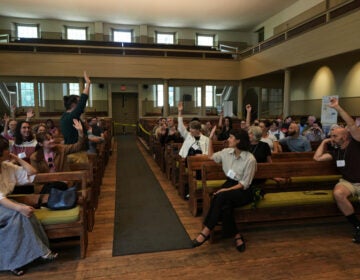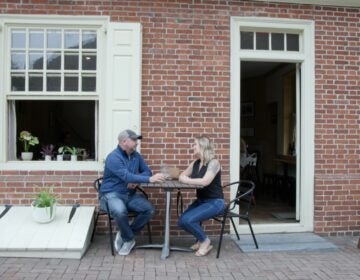Cartoons of Black Americans from the Civil War appear, then disappear, in Old City
The images of enslaved Black Americans were originally used to criticize the Confederacy, but out of historical context, they can offend.
Listen 2:22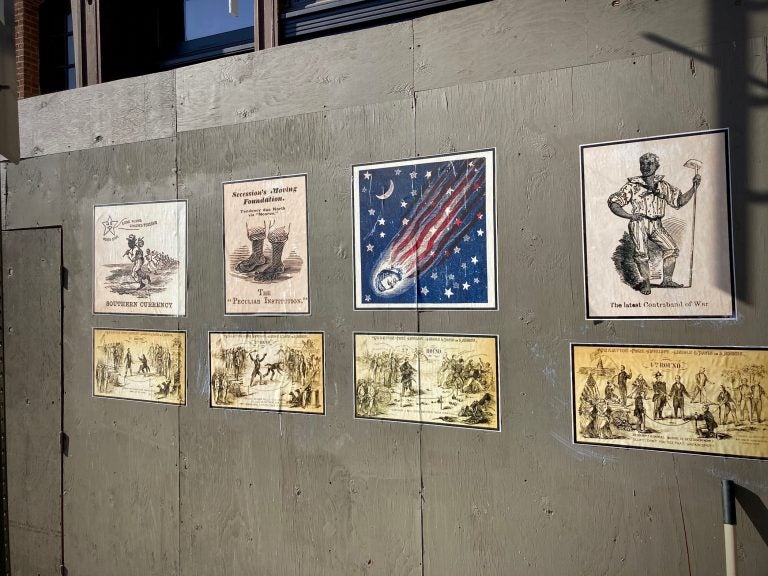
An exhibit of Civil War Era images displayed on a construction wall at 3rd and Chestut streets was quickly taken down by the Old City District. It was perceived as a hate crime. (Courtesy of Todd Kimmell)
On April 20, the day former Minneapolis police officer Derek Chauvin was found guilty of murdering George Floyd, an outdoor exhibition of Civil War-era cartoons was wheat-pasted to a plywood construction barrier on Chestnut Street in Philadelphia’s Old City.
Among the dozens of poster-sized images were some that depicted enslaved African Americans. One featured a portrait of Stephen Douglas, the Illinois senator and rival to Abraham Lincoln, who strongly defended states’ rights to allow for slavery, marked “Patriot.”

Considering the timing of the installation on the day of the historic verdict, the Old City District believed it was a hate crime. The district brought the posters to the attention of the landowners, who asked the district to take the posters down. The district complied.
The exhibition was created and installed by Todd Kimmell, a local printmaker. Under his company name The Grand Review, he collects historic images and reproduces them as posters for sale. He says the exhibition was not a hate crime, just the opposite. He was showing a series of political cartoons from the Northern Union directed against the Southern Confederacy.
Kimmell says if he was just given the opportunity to explain the images, it would make sense.
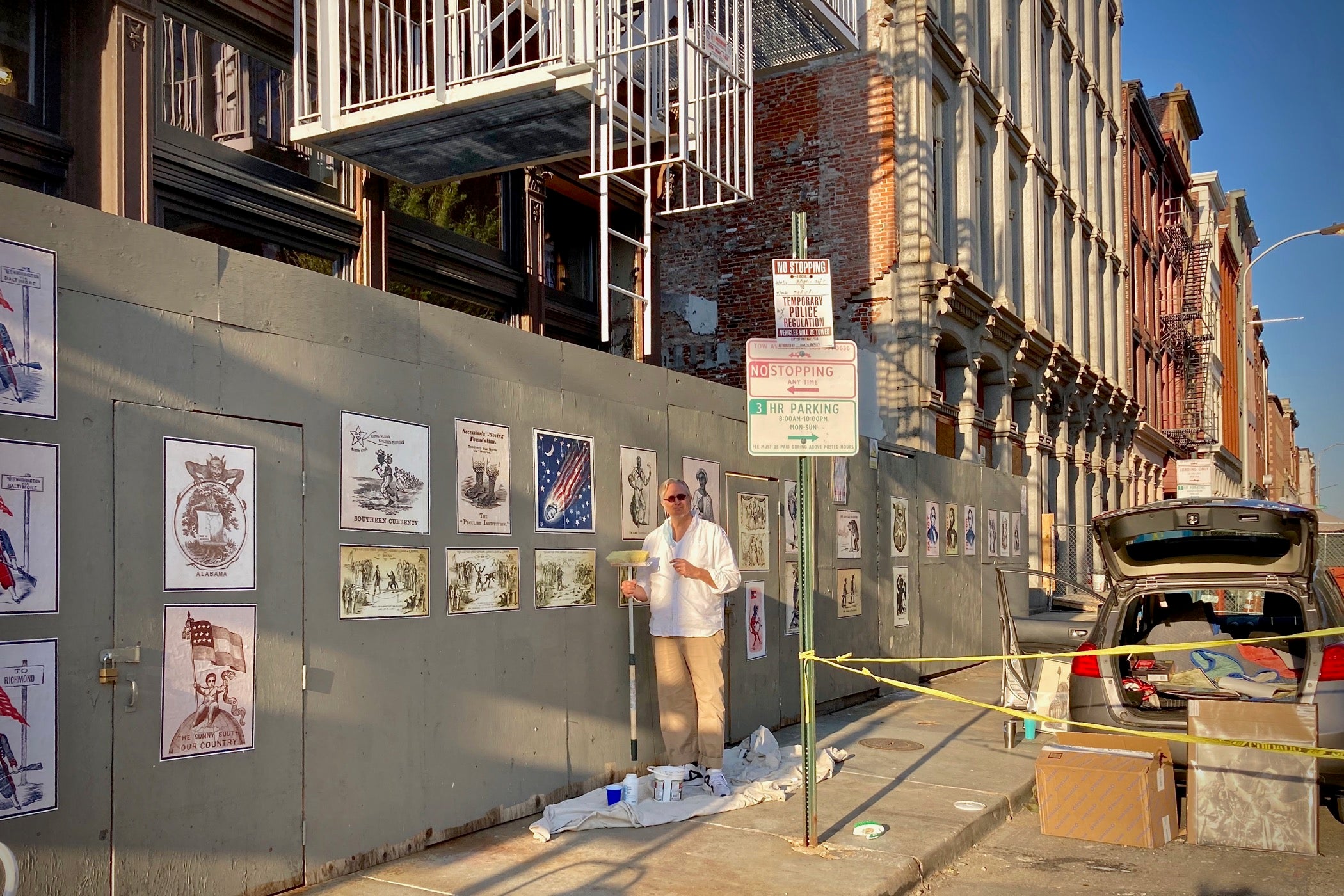
The images came from an obscure fad in mid-19th century America to use mailing envelopes printed with very small political cartoons, about two inches square. The images would be printed on the left of the envelope, leaving the right side to write the receiver’s address.
Normally these envelopes would be printed with advertising, but in the 1860s they were used to express opinions about the Civil War. Mostly the cartoons are from the perspective of the Union states pointing out the foibles and injustices of the Southern states.
“They’re individual images — often wry and wiseacre, that sort of thing — giving much of the raspberry from the North to the South,” said Kimmell. “The South participated a little bit in this short-lived fad, but immediately the South was pinched for everything, so nobody was going out and buying funny envelopes to thumb their nose at somebody through the mail.”
The images include a picture of the devil overlooking a map of Alabama, for example, or an image of Jefferson Davis, the leader of the South’s secession, with his head hung low being led to Washington D.C. by the point of a bayonet. It is sarcastically captioned “Jeff’s March on Washington.”

Some of the images may be difficult for contemporary audiences to understand. One is a close-up of bare Black feet, with the caption “Secession’s Moving Foundation. Tendency due North via ‘Monroe.’” The Black feet represent slavery as the South’s economic foundation. That economic base was leaving the South as African Americans ran away to the North.
The “Monroe” in the caption refers to Fort Monroe, a little-known chapter of the Civil War. Benjamin Butler, a Union general, was commanding Fort Monroe in Virginia where he refused to return runaway African Americans to Southern slave owners. Butler determined they were “contraband of war,” on par with other wartime assets such as weapons and supplies. Butler’s Fort Monroe quickly became a destination for runaways seeking refuge.
“Fort Monroe, where he declared this, became an instant small city of escaped slaves because the word spread like wildfire. People ran to Fort Monroe,” said Kimmell. “It’s a big deal.”
People of the 1860s would likely have known the story of Fort Monroe and the importance of the phrase “contraband of war.” Another envelope image featured a barefoot Black man, smiling and confident, holding a hoe. The caption reads “The latest contraband of war.”
As for that Stephen Douglas “Patriot” portrait: At the start of the Civil War he famously said, “There can be no neutrals in this war, only patriots and traitors.” Depending on what side of the war the printer was, portraits of politicians would be labeled “Patriot” or “Traitor.” The exhibition featured three such portraits: Douglas, California Senator John Frémont (“Patriot”), and Confederate Secretary of War John Breckenridge (“Traitor”).
Kimmell put up the images with the help of local artist Ben Woodward, who knew how to properly wheat-paste from his past work with famed street artist Shepard Fairey and doing “snipe” work: pasting guerilla advertising for hire. He liked the fact that the exhibition forced a conversation about the history of American racism, particularly during the trial of Chauvin and its impact on the legacy of George Floyd’s death.
“This isn’t a new phenomenon. We’ve been dealing with this forever as a country, and we need to face up to it,” he said, “That made sense to me. We should look back at ourselves and be, like, ‘Well, how do we do this? How do we get here?’”
That message was lost on an Old City District staff member who encountered the posters on a morning walk. That person took a picture and sent it to executive director Job Itzkowitz.
“I received the message at 9 a.m., electronically. That was a picture of Stephen Douglas with the word “Patriot” on the poster. The message as typed to me said, ‘Hate crime in Old City?’” said Itzkowitz. “Some of the rest of the images depicted a woman, presumably a slave, serving as a wet nurse for a white child. I mean, that’s a potent image. Without further context, and the timing — it’s really hard to understand what someone was trying to say there, in 2021.”
Itzkowitz’s first move was to contact the Philadelphia Commission on Human Relations. Then Itzkowitz contacted the owner of the lot around which the construction fencing was erected. One of Old City District’s purposes is to keep the neighborhood clean and maintained, but can clean graffiti off private property only at the request of the owner. The owner of 239 Chestnut Street asked that the posters be removed, and OCD complied promptly.
The saga gets complicated by the fact that the plywood fencing is built across two properties, 239 and 241 Chestnut Street, both being redeveloped after a devastating fire in 2018. Kimmell said he received permission to install the exhibition only from 241 Chestnut Street, which is a condominium development. As it turned out the person who gave permission was not authorized to speak on behalf of all the building’s condo owners.
Kimmell put up the images on a Tuesday, intending to return that Friday or Saturday to install explanatory texts accompanying the posters, just like a museum show.
“It was taken down before then because people didn’t understand what they were seeing,” he said. “I mean, most folks should have been able to look at those things if we taught it differently in school and said, ‘No, this is about the Northern perspective giving the raspberry to the South.”
Kimmell chalks up the incident as a series of miscommunications and lessons learned. He would still like to put up the posters in a public place in Philadelphia, next time getting firmer permissions and understandings from property owners.
WHYY is your source for fact-based, in-depth journalism and information. As a nonprofit organization, we rely on financial support from readers like you. Please give today.



